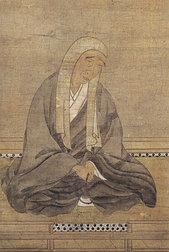- Shōkū
Infobox Buddhist biography
name = Shōkū (証空)

img_size =
img_capt = Undated portrait of Shoku. Photo courtesy of [http://www.eikando.or.jp/English/honen_e.htm Eikando Temple] , Japan
landscape =
birth_name =
other_names = Seizan (西山)
dharma_name =
birth_date = 1177
birth_place =Kyoto ,Japan
death_date = 1247
death_place =Kyoto ,Japan
nationality =
denomination =
school =Jodo Shu Buddhism,Seizan Branch
lineage =
title = Founder ofSeizan branch ofJodo Shu Buddhism
workplace =
education =
occupation =
teacher =Honen
reincarnation_of =
predecessor =
successor =
student =
spouse =
partner =
children =
website =Shōkū (証空 1147-1247), sometimes called "Seizan" was a disciple of
Hōnen , founder of theJodo Shu Buddhist sect. Shoku later succeeded another disciple of Hōnen,Jōhen as the head of a formerShingon Buddhist temple, Eikandō, established a separate branch ofJodo Shu called theSeizan branch (after its namesake), and completed the conversion of Eikandō from aShingon temple into aJodo Shu one.Biography
According to the temple's biography, Shoku was born into a noble family, but by 14 years of age took an interest in Buddhism. In one legend, his mother stood before a famous bridge to have his fortune told. At that time, a monk passed by chanting the
Lotus Sutra , which convinced her that he should be a priest. It was then that Shoku studied under Hōnen for 23 years. Later in life, he became a disciple ofJōhen , who had recently converted from theShingon faith to theJodo Shu faith, subsequently converting the Eikandō as well. Later Shoku took over as head of this temple, and fully converted the temple into a Jodo Shu temple, and began theSeizan branch.After Honen had died, Shoku also studied
Tendai and esotericShingon Buddhism extensively with a focus onPure Land teachings and practices. He wrote an extensive commentary on theTaima Mandala at the invitation of the head priest there.The temple biography mentions that Shoku was very intense in his study and practice, and would recite the
nembutsu up to 60,000 times a day, in addition to other ascetic practices. Shoku described his practice of the nembutsu as "Shiraki no Nembutsu", meaning that after studying the Buddhistsutras extensively, and engaging in other Buddhist practices, one should then recite thenembutsu with their whole heart. This echoes the words of Hōnen where one should study Buddhist teachings, but then return to the humble self to be saved byAmida Buddha.This approach to Pure Land Buddhism won favor among the established
Tendai sects, and so Shoku was one of the few of Hōnen's disciples who was not exiled or executed in the year 1207.References
* [http://www.eikando.or.jp/English/honen_e.htm Eikandō's official website] Contains history of Jodo Shu, the Seizan branch and Shoku
*
* [http://www12.canvas.ne.jp/horai/con-ex.htm The Taima Mandala] Image of the Pure Land from a medieval Japanese scroll, based on the descriptions found in the Contemplation Sutra. This site offers explanations in English of the various motifs of the scroll.
* [http://www.jsri.jp/English/Jodoshu/disciples/eras/4eras.html The History of Honen's Disciples]
Wikimedia Foundation. 2010.
